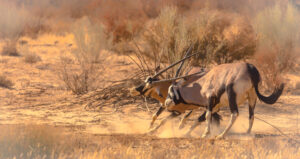
- Profile
- Tour Operators
- Accommodation
- prev
- next
Overview
The Kgalagadi Transfrontier Park is a merger of the Kalahari Gemsbok National Park in South Africa and the Gemsbok National Park in Botswana. Most tourism happens on the South Africa side, which has excellent facilities. The Botswana side only has very basic campsites. The red sand dunes in the inhospitable desert form a magnificent backdrop for wildlife viewing and photography. The park lacks many species found in the lush savannah reserves but offers great predator sightings.
In 1999, Botswana and South Africa signed a historic treaty, forming the first transfrontier conservation area (TFCA, or Peace Park) in Africa. Conservation experts proposed plans for the joint management and integration of South Africa's Kalahari Gemsbok National Park and Botswana's Gemsbok National Park as early as 1989. However, the parties could not fully realise these plans until South Africa came under democratic rule. Following South Africa's independence in 1994, and with the support and encouragement of the Peace Parks Foundation, negotiations were finalised with the Kgalagadi Transfrontier Park (KTP) officially opening in May 2002.
This immense wilderness (37,000 sq km) is now shared and jointly managed by both countries as a protected area. The entire park is completely unfenced, allowing wildlife to move freely along ancient migration routes that enable survival in the harsh desert environment.
Situated in Botswana's extreme southwest corner and adjacent to South Africa's Northern Cape Province, the KTP is managed as a single ecological unit, and gate receipts are shared. Tourist facilities, however, are still run autonomously.
Immigration and customs arrangements allow travellers to enter the park in one country and depart in the other. The main entry and departure point between the two countries are at the Two Rivers/ Twee Rivieren Gate, which also has camping facilities, chalets, shops and a restaurant.
The national boundary with South Africa runs along the dry Nossob River bed, with three-quarters of the KTP area within Botswana borders. Currently, KTP is visited by self-drive campers, with a few operators offering mobile tours.
There are three main areas to explore: the Nossob River valley, along the South Africa/Botswana border; the wilderness trails on the Botswana side, and what was once the Mabuasehube Game Reserve, now incorporated into KTP at its most northeastern reaches.
The Government of Botswana has allocated five fixed lodge sites for development by the private sector.
To maintain the KTP's pure wilderness experience, authorities strictly control the number of vehicles that travel the wilderness trails, the number of nights a camping party can stay at a campsite (usually limited to one night) the number of people at each camp. Hence, booking well in advance is essential.
Self-drive campers must travel in a convoy of a minimum of two vehicles, and the rough and sandy roads mean that intrepid explorers use well-equipped 4x4 vehicles only.
KTP's stunning terrain includes fossil river valleys dotted with dwarf trees and bushes, grasslands and dunes of many colours. Wildlife is abundant, and the animals are attracted to waterholes along the otherwise dry riverbed.
The KTP is home to several antelope species, including the ubiquitous springbok and gemsbok, hartebeest, eland, and the famous black-maned Kalahari lion, jackal, brown hyena, and wild cats.
Rich birding is always part of the experience. Over 170 species of birds are present here, and it is not uncommon to see over 30 bird species within a few kilometres of the campsite.
At Mabuasehube, the terrain is a mixture of typical Kgalagadi tree and shrub savanna with patches of open grass savanna.
This area of KTP comprises a series of huge pans, which are the principal focus of the reserve. Campsites dot the various pans, and many are situated on slight promontories, giving almost unimpeded vision, thus making for good game viewing right from your camp-side chair.
Three of the largest pans lie along the main road; Bosobogolo, Mpayathutlwa and Mabuasehube. Others, such as Leshologago, Khiding and the fossil valley complex called Monamodi, are linked to the larger pans by sand tracks.
Each pan is unique. The Mabuasehube pan floor is bare clay rich in salts, which attracts animals that come to lick the surface, deriving essential minerals. The base of Bosobogolo pan is short, shrubby grassland, which antelope frequent to graze, accompanied, of course, by predators.
Mabuasehube is home to many main predators, including the Kalahari black-maned lion, cheetah, leopard, brown hyena, bat-eared fox, lynx, and silver fox. Like the Cape fox, sharp-eyed visitors can view small mammals such as aardwolf and black-footed cat in the pans in the evening.
Activity highlights in KTP include the following:
Kgalagadi Transfrontier Park & Tsabong Ecotourism Camel Park
Wilderness drives
Mobile camping
Sand Dune climbing
Sand boarding
Camel ride
Quad biking
Location
-
R360, Kalahari Gemsbok National Park, Kgalagadi 8811, South Africa
Vital Park Information
South Africa
38 000 km²
South Africa is one of the few countries in the world where tap water is still regarded as relatively safe to drink, particularly in big cities such as Pretoria and Cape Town.
South African rand (ZAR)
Low Risk - Not necessary to take anti-malaria drugs
March, April, May, June, July, August, September, October
Wildlife viewing is always good in Kgalagadi but at its best at the end of the rains (March to May) when animals congregate around the riverbeds. This makes for easier sightings. However, Kgalagadi gets extremely hot during summer – the cooler winter months (May to September) are the most pleasant.





